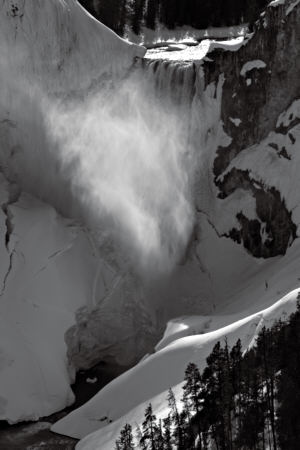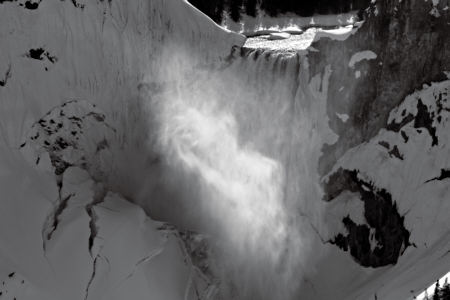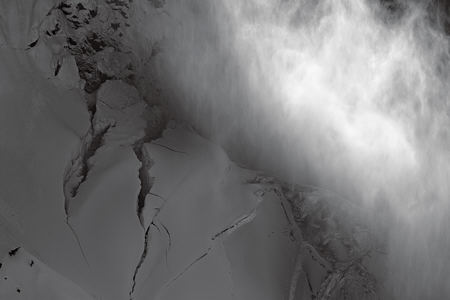
While reworking and sequencing my Winter Water project, I realized that, for a photographer as well as a physicist, snow, ice, and liquid are very distinct states of water, with distinct texture, tone, and shape. Perhaps because those photographs had no sky, I managed to completely forget about the vaporous state. Last Monday, however, I was vividly reminded of that glorious phase while biking through Yellowstone. Roads were clear but cars not yet allowed, so I had it almost to myself: only a half dozen other bikers all day, and a few service vehicles per hour. Fortunately I had a late start, so by the time I reached the Lower Falls it was well on in the afternoon. The westerly light left the falling water in shade while illuminating the mist.

The constantly changing shapes were mesmerizing and kept me occupied as long as I dared stay. There’s clearly a reason for the overused description wraithlike. It was unusually dynamic because it was very windy; in fact, I finally lost my hat (a baseball-style cap like June’s) down the canyon, and was in no way tempted to go after it.
Besides the mist, there were some intriguing crevasses that had opened up in the snow pack. The sharp tears in the smooth surface made a nice contrast with the hovering mist.

On the way back I stopped for a more peaceful image at a thawing lake. There seemed to be something a mystical about the neatly sliced mound of snow. I suspect I could be happy photographing nothing but the infinite forms of water.

Which leads me to think about the benefits of narrowing one’s focus, one’s effort. The nature of a project is such a focusing, but I frequently wonder if I don’t have too many projects in hand. They often conflict; I can’t do more than one thing at a time, and the time is so limited. Do you also feel pulled in too many directions artistically? Or, on the contrary, do you want to broaden your scope?

Steve and all,
I’m finally back from my mini-vacation from A&P. Just in time to comment on Steve’s ideas and images.
First, the mound of melting snow in the lake is absolutely fascinating. As a painter, I am intrigued by how clearly we know what is happening there, when it is all texture and light. Further, of course, I would love to know how to reproduce that effect in paint. I think there must be “painters of snow” and allied objects whose specialty is evoking just that thing that Steve has evoked in his photography. But it’s not me. I’m working on a marsh at the moment and struggling to get it right. Any struggle with something like the snow melt in pond for me is almost frightening
As to your question: I’m always involved in too many projects. In part, it’s because I lost important working years of my life to illness, so I’m still trying to catch up. But in part, it’s just my temperament. Maybe I have a short attention span, but I need to move from project to project to prevent staleness.
That said, the distraction and multiple pulls can be maddening, particularly when I’ve set myself goals and then have to try to meet them as they pile on one another.
“A man’s [sic] reach should exceed his grasp,” said Robert Browning, and while it’s a not very lucid and somewhat sexist quote, it sticks with me. I’m always pushing for what is out of reach, and sometimes that actually gets me beyond my current capabilities. And sometimes it simply makes me a little crazy.
Steve:
Ah, to have a Yellowstone around here. The best that could be managed in these parts this last winter was yellow snow.
And I agree that the mounds of snow on the pond do look like polar bears. Reminds me of a family visit to Yellowstone where my visually-challenged grandmother returned to the cabin one night, complaining of a loud woman in a fur coat blocking her access to the outhouse. Turns out that she had been standing patiently behind a bear raiding a garbage can. But that has nothing to do with this post.
Regards your question: it seems a matter of what brings you to art. Some folks are just curious about what’s over the next hill, others may be seeking personal betterment and yet others are more careerist in their approach – and these are just three of an infinity of options. Me, I’m so-so in what I can accomplish, but I have no other ambition but to make things. And technical issues interest me far more than aesthetic.
The pictures of the mist are great! The immediacy of the vaporous state offers a novel texture.
You used ‘ more peaceful’ as an attribute for the last picture. Why peace? Is a slow change more peaceful than a fast change? Is there a difference in danger between dancing mist and slowly melting ice?
It seems to depend on one’s point of reference. Sitting in an internet café in Germany, I can imagine that breaking through the slowly melting ice is as deadly as being pushed by wind. I am remembering that George Klein, a molecular biologist who survived the holocaust in Hungary, almost died cross-country skiing on a lake in Sweden.
June,
The thought of trying to capture the light in these pictures through painting is scary; it’s hard enough with tools like camera and computer.
I agree that the mounds of snow on the pond do look like polar bears
Jay, who said that? It’s your active imagination, which of course is also reflected in your multitudinous and fascinating projects. Now that you’ve said it, I see a polar bear diving for a fish, butt and hind legs showing above water.
Birgit,
That’s a good point about peace. What makes a scene peaceful. Aside from the blowing wind and the changing mist and water, which are not directly evident, I guess it is the greater contrast and greater detail in the first image that makes it seem less peaceful to me. As you point out, though, personal associations could change everything. I can imagine having a languorous picnic with view of the falls, or a sudden crack in the ice disturbing the lake scene.
Steve, I have to say that the luminosity captured in the mist is a marvel.
Steve,
My earlier comment was posted when I felt contrary.
The mists are wonderful and so is the melting ice.
The mists are a gift from the heavens to prevent the viewer of your ‘states of water’ to be overwhelmed, saturated, even bored (dare I say so?) with largely frozen waterfalls.
Touché! I promise, no more waterfalls for at least a week. And I appreciate your contrary comments.
Steve:
Does any aspect of a rainbow register in b&w? I ask this as Niagara, the most voluminous waterfall that I have experienced, almost always has a rainbow hovering about. Then again, a mist of ice crystals, as I assume that in your images to be, may not have the requisite refractive qualities. A rainbow in black and white is a wondrous thing to contemplate.
Jay,
The problem with rainbows is they’re usually faint, so they are usually less prominent in black and white, which lacks the sequence of adjacent colors to catch the eye’s notice. Of course, there are tricks to enhancing a rainbow, but I have only one phto of a rather poor one, so I’ve never tried.
The mist is water droplets, not ice, though maybe it could be ice crystals on a very cold winter day. In that case, one can see a phenomenon called sun dogs when looking toward the sun. But despite the lingering snow and ice, my visit was on a warm day 50’s F. However, to capture the best rainbow I would probably have to be beside the falls, not too far from the bottom, looking away from the sun. There are limits to my intrepidity!
Steve,
With your intrepidity, you are the Robert Capa of A&P:
Steve,
I did not make myself clear. I love looking at your waterfalls here on A&P.
What I had in mind was the sequence of the different states of water that you are assembling for publication. Introducing the mists into the sequence will prevent the viewer´s eyes from glazing over from too much repetition of similar images.
Steve:
Saw a wonderful sun dog – if that is indeed what it was – from the window of a plane as it came in to land. The shadow of the aircraft as it raced over the ground was surrounded by a bright halo, in somewhat separated colors. The apparition continued to draw near until it met us at the end of the runway.
and, yes, 50 degrees F is hardly conducive to clouds of ice.
Steve,
Did you change the photos to enhance the light and darken the undershadows? Or are my eyes (or memory or environment) playing tricks on me?
Today the vapors seem far more lit than they did yesterday!
June,
I changed nothing with the pictures. Unfortunately, this sort of thing depends on one’s monitor settings (are you at the same computer?) as well as state of enlightenment (are you feeling brighter today?)
I appreciate your earlier compliment, as in fact it is non-trivial to bring the mist out well, showing the structure in it while getting the brightness level right in relation to the rest of the image. In a simple snapshot it would either appear too bright and washed out, or the darker areas would be pure black, with no detail.